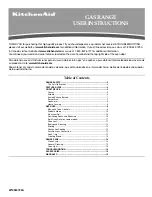
49-88073
23
Problem
Possible Cause
What To Do
Surface units will not
maintain a rolling boil
or cooking is not fast
enough
Improper cookware being used.
8VHSDQVZKLFKDUHIODWDQGPDWFKWKHGLDPHWHURIWKH
surface unit selected.
,QVRPHDUHDVWKHSRZHUYROWDJHPD\EH
low.
Cover pan with a lid until desired heat is obtained.
Coil surface units do
not work properly
The surface units are not plugged in
solidly.
With the controls off, check to make sure the surface
unit is plugged completely into the receptacle.
The surface unit controls improperly set.
Check to see the correct control is set for the surface
unit you are using.
The drip pans are not set securely in the
cooktop.
With the controls off, check to make sure the drip pan is
in the recess in the cooktop and that the opening in the
pan lines up with the receptacle.
A fuse in your home may be blown or the
circuit breaker tripped.
Replace the fuse or reset the circuit breaker.
Sensi-Temp Technology sensor cap is
overly soiled.
Clean Sensi-temp Technology sensor cap per cleaning
the range section.
Sensi-temp sensor cap stuck or will not
flex up and down.
Call a qualified technician for replacement. Replace coil
surface units with only the exact replacement part.
Surface units do not
work properly
A fuse in your home may be blown or the
circuit breaker tripped.
Replace the fuse or reset the circuit breaker.
Cooktop controls improperly set.
Check to see the correct control is set for the surface
unit you are using.
Surface unit stops
glowing when turned
to a lower setting
The unit is still on and hot.
This is normal.
Scratches (may appear
as cracks) on cooktop
glass surface
Incorrect cleaning methods being used.
Scratches are not removable. Tiny scratches will
become less visible in time as a result of cleaning.
Cookware with rough bottoms being used
RUFRDUVHSDUWLFOHVVDOWRUVDQGZHUH
between the cookware and the surface
of the cooktop. Cookware has been slid
across the cooktop surface.
To avoid scratches, use the recommended cleaning
procedures. Make sure bottoms of cookware are clean
before use, and use cookware with smooth bottoms.
Areas of discoloration
on the cooktop
Food spillovers not cleaned before next use. See the Cleaning the glass cooktop section.
Hot surface on a model with a light-colored
cooktop.
This is normal. The surface may appear discolored
when it is hot. This is temporary and will disappear as
the glass cools.
Plastic melted to the
surface
Hot cooktop came into contact with plastic
placed on the hot cooktop.
6HHWKH*ODVVVXUIDFH²SRWHQWLDOIRUSHUPDQHQWGDPDJH
section in the Cleaning the glass cooktop section.
Pitting (or indentation)
of the cooktop
Hot sugar mixture spilled on the cooktop.
Call a qualified technician for replacement.
Frequent cycling off
and on of surface units
Improper cookware being used.
8VHRQO\IODWFRRNZDUHWRPLQLPL]HF\FOLQJ
My new oven doesn't
cook like my old one.
Is something wrong
with the temperature
settings?
Your new oven has a different cooking
system from your old oven and therefore
may cook differently than your old oven.
For the first few uses, follow your recipe times and
temperatures carefully. If you still think your new oven
is too hot or too cold, you can adjust the temperature
yourself to meet your specific cooking preference.
NOTE:
7KLVDGMXVWPHQWDIIHFWV%DNHWHPSHUDWXUHVLW
ZLOOQRWDIIHFW%URLO
Troubleshooting Tips ...
%HIRUH\RXFDOOIRUVHUYLFH
Save time and money! Review the charts on the following pages first and you may not need to call for service.
TROUBLESHOOTING
TIPS
















































